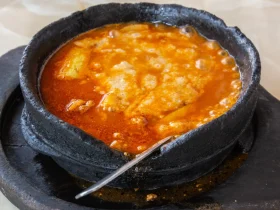Spanish Potato Omelette, known as “Tortilla Española” in Spain, is a beloved dish that combines the humble ingredients of eggs, potatoes, and onions into a flavorful and satisfying meal. This iconic Spanish recipe has gained international recognition for its simplicity and delightful taste. If you’re looking to create a genuine Spanish culinary experience in your own kitchen, follow this step-by-step guide to prepare a mouthwatering Spanish Potato Omelette.
[ez-toc]
History
The history of the Spanish Potato Omelette, or “Tortilla Española,” is as rich and diverse as the flavors it encapsulates. This iconic dish is not only a culinary delight but also a symbol of Spanish culture. Let’s delve into its fascinating history.
The origins of the Spanish Potato Omelette are a subject of debate, but it is widely believed to have originated in Spain in the 19th century. While the exact origin story is elusive, it’s clear that this dish quickly became a staple of Spanish cuisine.
Early Beginnings
The earliest versions of the omelette were much simpler than the contemporary recipe. The essential ingredients were eggs, potatoes, and onions, reflecting the humble, readily available produce in Spain. This uncomplicated combination was loved for its hearty and satisfying nature, making it a perfect meal for the working class.
Evolution and Popularity
As the years went by, the Spanish Potato Omelette gained immense popularity, both within Spain and beyond. It became a common sight in Spanish households, bars, and restaurants, eventually evolving to include regional and personal variations. Some added bell peppers, chorizo, or even cheese, creating an array of unique flavors.
The dish’s adaptability is a testament to its versatility, making it a beloved recipe that transcends generations and continues to satisfy a wide range of tastes.
Cultural Significance
The Spanish Potato Omelette holds a special place in Spanish culture. It’s not just a meal; it’s a social experience. In Spain, it’s often enjoyed as a tapa, a small snack typically served in bars alongside a glass of wine or a cold beer. This communal aspect of enjoying omelette tapas brings people together, fostering a sense of community and shared tradition.
The dish is also a prominent feature of Spanish fiestas, picnics, and family gatherings. Its adaptability makes it suitable for various occasions, from casual get-togethers to formal events.
Furthermore, the Spanish Potato Omelette has garnered international recognition as Spanish cuisine has gained global popularity. Travelers to Spain often seek out this traditional dish to experience a taste of authentic Spanish culture.
Time
| Step | Time Required |
|---|---|
| Preparation | 15 minutes |
| Cooking | 25 minutes |
| Total | 40 minutes |
Please note that these times are approximate and may vary depending on your cooking skills and the specific equipment you use.
Ingredients
| Ingredients | Quantity |
|---|---|
| Eggs | 4 large |
| Potatoes | 2 medium-sized |
| Onion | 1 |
| Olive oil | As needed |
| Salt | To taste |
| Pepper | To taste |
These quantities are adjusted for a serving size of two people, but you can always scale the recipe up or down as needed.
Directions
Step 1: Preparation
1.1. Peel the Potatoes
- Start by peeling and washing two medium-sized potatoes.
1.2. Slice the Potatoes and Onion
- Slice the peeled potatoes into thin, round discs.
- Dice the onion finely.
1.3. Heat Olive Oil
- In a large skillet, heat olive oil over medium-high heat.
1.4. Fry Potatoes and Onions
- Add the sliced potatoes and diced onions to the hot olive oil.
- Fry them until they become tender and slightly golden, stirring occasionally.
- Once cooked, remove them from the skillet and drain any excess oil.
Step 2: Cooking
2.1. Beat the Eggs
- In a bowl, beat four large eggs.
- Season with salt and pepper to taste.
2.2. Combine Eggs and Fried Ingredients
- Add the fried potatoes and onions to the beaten eggs.
- Mix the ingredients together thoroughly.
2.3. Heat a Clean Skillet
- Heat a clean skillet and add a bit of olive oil.
2.4. Cook the Omelette
- Pour the egg and ingredient mixture into the skillet.
- Cook on low heat, allowing the omelette to set slowly.
Step 3: Techniques for Flipping
3.1. Start Flipping
- When the edges of the omelette start to set, it’s time to flip it.
- Use a large plate to cover the skillet and carefully flip the omelette onto the plate.
3.2. Return to Skillet
- Slide the flipped omelette back into the skillet to cook the other side.
- Cook until both sides are nicely golden brown.
Step 4: Serving
4.1. Serve at Your Preference
- Spanish Potato Omelette is traditionally served at room temperature, making it perfect for picnics or tapas.
- You can also serve it warm if you prefer.
4.2. Accompaniments
- It pairs wonderfully with a simple green salad, crusty bread, or a dollop of aioli.
Enjoy your delicious Spanish Potato Omelette!
Equipment Required
Nutrition Information
| Nutritional Information | Amount per Serving |
|---|---|
| Serving Size | 1/4 of the omelette (approx. 2 eggs’ worth) |
| Calories | 250-300 calories |
| Fat | 15-20 grams |
| Protein | 10-12 grams |
| Carbohydrates | 20-25 grams |
| Fiber | 2-3 grams |
| Sugar | 1-2 grams |
| Cholesterol | 200-250 mg |
| Sodium | 400-500 mg |
Please note that the exact nutritional content may vary depending on the specific ingredients and cooking methods used. The values provided here are approximate and can be adjusted based on variations and substitutions.
Tips
- Choose the Right Potatoes: Opt for waxy potatoes (such as Yukon Gold or red potatoes) as they hold their shape better during cooking.
- Slow and Steady Cooking: Don’t rush the cooking process. Cooking the omelette over low heat ensures it cooks evenly without burning.
- Well-Seasoned Skillet: Use a well-seasoned skillet or a non-stick pan to prevent sticking and for better flavor.
- Uniform Slicing: Ensure that the potatoes and onions are sliced evenly to ensure uniform cooking.
- Don’t Overcrowd the Pan: Fry the potatoes and onions in batches if necessary to avoid overcrowding the skillet, which can lead to uneven cooking.
- Use a Plate for Flipping: When flipping the omelette, use a large plate that covers the skillet completely to avoid any spills or accidents.
- Practice Flipping: Flipping an omelette can be challenging. It’s a good idea to practice with a smaller omelette or use a lid to cover the skillet while cooking if you’re unsure about flipping.
Pros & Cons
| Pros | Cons |
|---|---|
| ✅ Delicious and Flavorful | ❌ High in Calories |
| ✅ Simple and Easy to Make | ❌ Relatively High in Fat |
| ✅ Versatile Dish | ❌ May Take Time to Perfect Flipping Technique |
| ✅ Suitable for Various Occasions | ❌ Not Ideal for Those with Dietary Restrictions |
| ✅ A Symbol of Spanish Culture | ❌ Requires Some Cooking Skill |
Conclusion
In conclusion, Spanish Potato Omelette, or “Tortilla Española,” is a culinary gem that encapsulates the essence of Spanish culture and flavors. This dish is a beautiful marriage of humble ingredients—eggs, potatoes, and onions—crafted into a hearty and satisfying meal. Its history, spanning over a century, is a testament to its enduring popularity and adaptability.
What makes Spanish Potato Omelette truly remarkable is its versatility. You can enjoy it as a tapa in a bustling Spanish bar or serve it as a main course during a family gathering. It’s equally at home as a casual picnic option or a comforting weeknight dinner.
As you embark on your culinary journey, remember that this recipe is forgiving and open to interpretation. You can add your personal twist with ingredients like bell peppers, chorizo, or cheese. For those with dietary restrictions, there are options to make it vegan or gluten-free. The variations are endless, making this omelette a canvas for your creativity.
So, don your apron, gather the ingredients, and step into the world of Spanish cuisine. Whether you’re an experienced cook or just beginning your culinary adventure, Spanish Potato Omelette is a must-try. It’s a dish that will not only tantalize your taste buds but also bring the heartwarming spirit of Spain to your table.
Don’t hesitate—get cooking and savor the magic of Spanish Potato Omelette for yourself. ¡Buen provecho!
Facts
- 1. The Omelette with Many Names 🍳
- The Spanish Potato Omelette is known by various names around the world. In Spain, it’s “Tortilla Española,” while in South America, it’s “Tortilla de Patatas.” In France, it’s called “Tortilla de Pommes de Terre.” Each name reflects its local identity, adding to its global charm.
- 2. A Star of Spanish Cinema 🎥
- This beloved dish has made its way into Spanish cinema. In the movie “Tortilla Soup,” the Spanish Potato Omelette plays a leading role as the favorite dish of a chef’s family, showcasing its importance in Spanish culture.
- 3. A Thick or Thin Debate 🧐
- In Spain, there’s a friendly debate about the thickness of the omelette. Some prefer it thick and substantial, while others like it thin and delicate. It’s a matter of personal preference and a topic of conversation at many Spanish dinner tables.
- 4. A National Day of Celebration 🇪🇸
- In Spain, the Spanish Potato Omelette has its own day of celebration. October 3rd is recognized as “National Spanish Potato Omelette Day.” Spaniards across the country come together to enjoy and celebrate this iconic dish.
- 5. The Tortilla Española in Space 🚀
- Believe it or not, an omelette traveled to space! In 2012, astronaut Samantha Cristoforetti cooked a Spanish Potato Omelette aboard the International Space Station, giving it a cosmic twist and proving that even in space, this dish is out of this world! 🌌🥔🍳
FAQ’s
Is it necessary to use olive oil for frying the potatoes and onions?
Olive oil is traditionally used for its flavor, but you can use other cooking oils if preferred.
Can I make the omelette in advance and reheat it?
Yes, you can make it ahead and reheat gently in the oven or microwave, though it’s best enjoyed fresh.
How long can I store leftover omelette in the refrigerator?
Leftovers can be refrigerated for 2-3 days. Make sure to store them in an airtight container.
What’s the difference between a Spanish omelette and a regular omelette?
Spanish Potato Omelette typically contains potatoes and onions, giving it a unique texture and flavor compared to a traditional omelette.
Can I freeze Spanish Potato Omelette?
Freezing is not recommended, as it can affect the texture and quality of the omelette.
What are some common mistakes to avoid when making this dish?
Common mistakes include overcrowding the skillet, using too much oil, and not cooking the omelette on low heat.
What are some popular condiments or sauces to serve with the omelette?
It’s often served with aioli, a garlic mayonnaise sauce, or with a simple tomato salad.
Can I make the omelette using sweet potatoes instead of regular potatoes?
Yes, you can use sweet potatoes for a unique and slightly sweeter twist on the classic recipe.
Are there any recommended side dishes to serve with Spanish Potato Omelette?
It pairs well with a green salad, crusty bread, or pickles. A glass of Spanish wine complements it nicely too.
Is it possible to prepare this recipe with pre-cooked or leftover potatoes?
Yes, using pre-cooked or leftover potatoes is a time-saving option, though it may slightly alter the texture. Simply reheat them before mixing with the eggs.












Leave a Review